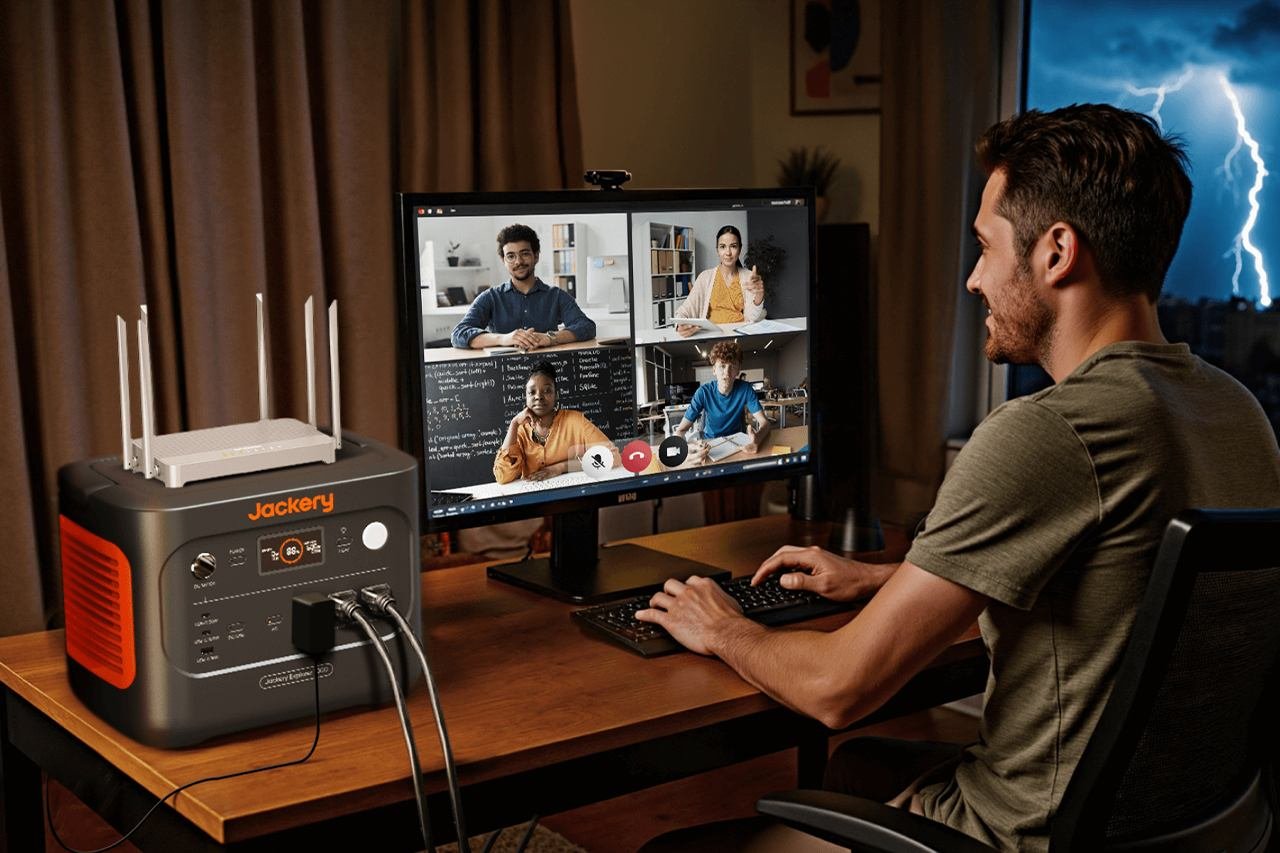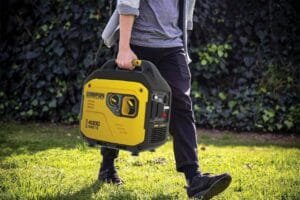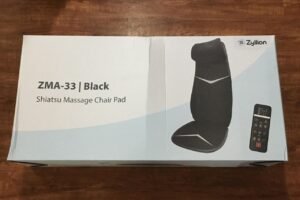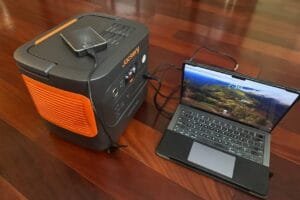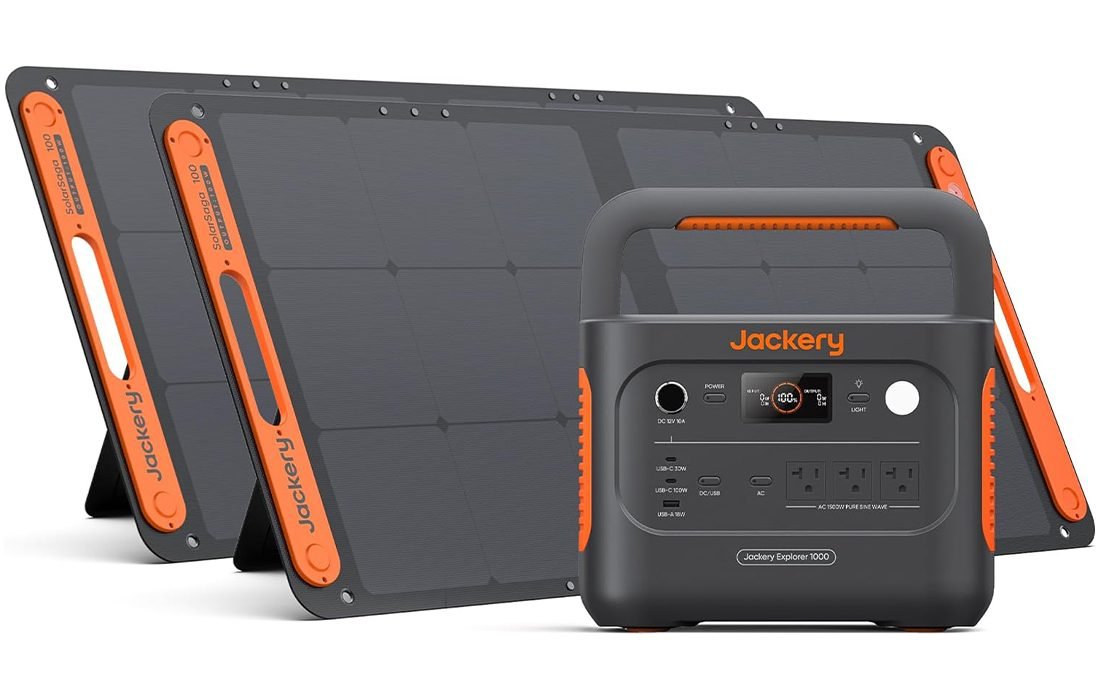
Jackery Explorer 1000 v2 — Fast-Charging 1kWh LFP Power Station
Our take: a compact, 23.8-lb solar generator that delivers 1,500W AC power, 1-hour emergency fast charging, and long-life LiFePO₄ reliability.
- 1,070Wh LiFePO₄ pack • ≈4,000 cycles to ≥70% capacity
- 1,500W AC (3,000W surge) runs coffee makers & fridges
- 1h Emergency Charge • 1.7h Fast AC • 5h Quiet ≈30 dB
- Ports: 3× AC, USB-C 100W + 30W, USB-A 18W, 12V/10A car
- App control • ChargeShield 2.0 • UL 2743 & FCC Class-B
- Capacity
- 1,070Wh (LFP)
- AC Output
- 1,500W / 3,000W surge
- Charge Time
- 1h / 1.7h / 5h
- Weight
- ≈23.8 lb
If you spend time off-grid—weekend camping, van life, tailgating, or just want a rock-solid home emergency backup—the Jackery Explorer 1000 v2 hits a very sweet spot. It’s a 1,070Wh LiFePO₄ (LFP) portable power station paired here with two 100W folding solar panels, designed to keep everyday appliances and personal tech humming without the noise, fumes, and maintenance of a gas generator.
This “v2” is a genuine overhaul, not a minor refresh. It delivers 50% more AC power (1,500W continuous, 3,000W surge) than the original Explorer 1000, charges dramatically faster (as little as 1 hour in its super-charge mode), and swaps to a long-life LFP battery rated for 4,000 cycles to 70% remaining capacity. It also brings modern touches like app control, 100W USB-C PD in/out, and a quieter, smarter charging profile for overnight use.
Jackery built its name on approachable, reliable solar generators. The Explorer 1000 v2 leans into that DNA, but with a performance ceiling that covers real appliances—coffee makers, induction hot plates, compact heaters, fridges—while remaining compact at 23.8 lb with an easy-carry handle. In short, it’s the kind of unit you can lift with one hand yet trust to anchor a base camp or get you through a power cut.
Is the Jackery Explorer 1000 v2 for you?
What need does it solve?
It replaces a small gas generator for most day-to-day situations: quiet, zero-emission power you can use indoors, in a tent, or in the back of your SUV. With 1,070Wh on tap and 1,500W AC output, it runs kitchen countertop appliances in bursts, keeps a fridge cold during outages, and charges laptops, drones, cameras, ebike batteries, and tools.
Who is it for?
Campers, RVers, overlanders, storm-prep households, mobile professionals, and content creators who want fast charging, long battery life, and the simplicity of plug-and-play power. If you frequently run devices between 50W and 1,200W (coffee maker, electric skillet, projector, Starlink, etc.), this size is a bullseye.
Who is it not for?
Anyone needing to power multiple heavy-draw appliances at once or a single device above 1,500W continuous (e.g., large space heaters, hair dryers on high, full-size microwaves, AC compressors) should step up to a 2–3kW class station. Ultralight backpackers should also look elsewhere; 23.8 lb is “portable,” not “pocketable.”
Where it sits on budget:
Firmly mid-tier premium. You’re paying for LFP longevity, very fast charging, and brand reliability—without the cost or heft of 2kWh+ monsters.
Beginner-friendly?
Yes. The interface is simple, the app helps you pick charging modes, and the included solar panels are fold-and-go. You don’t need to be “solar fluent” to get excellent results.
What We Like About the Explorer 1000 v2
The headline improvement is speed. The unit can go from empty to full in about 1 hour in “Emergency Super Charging” (enabled in the app) or ~1.7 hours in its default fast-charge AC mode. There’s also a “quiet” 5-hour charge profile (≈30 dB) that’s perfect when you’re asleep in a small space. On solar, it’s optimized for up to 400W input; Jackery quotes about 3 hours at the full 400W, which matches field experience when the sun cooperates.
The shift to LiFePO₄ chemistry is huge. LFP brings a dramatically longer life—~4,000 full cycles to 70% capacity—better heat tolerance, and more stable behavior under load. That’s a decade of typical weekend use, which makes the v2 feel like a long-term tool instead of a consumable gadget.
Power output is now 1,500W AC / 3,000W surge, so you can actually run real cookware, a 1,080W coffee maker, a 1,200W space heater on low, projectors, or a compact electric grill. The three AC outlets are pure sine wave and stable. On the DC side, the addition of 100W USB-C PD (plus a second 30W USB-C and an 18W USB-A) means you can fast-charge laptops and tablets without a wall brick, while also topping off cameras, drones, and phones.
The app is genuinely useful. Besides remote monitoring and toggling outputs, you can pick between charging profiles (super-fast, fast, and quiet), enable energy-saving mode, and check battery health. That control matters if you’re trying to balance fast turnarounds with long battery life.
Finally, Jackery’s build quality and ecosystem polish stand out. The case feels tough, the handle folds, the display is clear, the ports are spaced well, and the SolarSaga panels are lightweight, self-standing, and tidy to store. Safety features add confidence: UL 2743 listing, FCC Class-B EMI, and Jackery’s ChargeShield 2.0 with “up to 62 forms of protection.”
What We Don’t Like About the Explorer 1000 v2
The “1-hour” charge is fantastic, but it’s an app-enabled emergency mode. That’s sensible—any battery prefers slower charging for longevity—but it means your everyday “plug and forget” time is closer to 1.7 hours on AC. Still quick, but worth understanding.
Solar reality rarely matches lab math. The bundle here is 2×100W (200W) panels. In ideal sun you’ll see 140–180W total; in shoulder seasons or hazy conditions, it can dip under 120W. That stretches the time to full beyond the “3 hours” Jackery quotes for 400W input. You can add more panel wattage, but that increases cost and carry bulk.
At 23.8 lb, it’s portable, not featherweight; you don’t backpack it. The USB-C mix (one 100W, one 30W) is good but not perfect if you’re trying to fast-charge two power-hungry laptops at once. And while 1,500W covers most countertop appliances, it still won’t handle everything—high-draw hair dryers, big space heaters, or full-size microwaves on high can trip the inverter.
Cold-weather users should note the 0°C (32°F) minimum charge temperature; like most LFP stations, you shouldn’t charge it below freezing. Discharge to –10°C (14°F) is fine. Plan to warm the unit inside a tent/vehicle before charging on alpine trips.
Pros & Cons
| Pros | Cons |
|---|---|
| True generational leap vs. original: 1,500W AC, 3,000W surge, 1,070Wh LFP | “1-hour” super-charge requires enabling emergency mode in the app |
| LFP battery: ~4,000 cycles to 70%—excellent longevity | Two USB-C ports, but only one is 100W; power users may want dual 100W |
| Very fast AC charging (~1.7h default) + quiet 5h overnight mode | 23.8 lb is carry-able, not hiking-friendly |
| Useful app: mode selection, remote monitoring, energy-saving | 1,500W ceiling won’t run some hair dryers, large heaters, or big microwaves |
| Mature ecosystem and safety (UL 2743, FCC Class-B, ChargeShield 2.0) | Included 200W solar is convenient but slower than the 400W best-case figures |
| Clean port layout: 3×AC, 100W USB-C, 30W USB-C, USB-A, 12V car | 0°C minimum charge temp limits cold-weather charging |
What’s Included?
- Jackery Explorer 1000 v2 power station (1,070Wh LFP, 1,500W AC / 3,000W surge)
- Two 100W SolarSaga folding solar panels (bifacial design, lightweight stands)
- AC charging cable
- User manual
- App pairing/quick start guide
- Warranty coverage (up to 5 years)
Our take on the package: For a “grab-and-go” solar generator, this bundle is well chosen. The 2×100W panels are easy to manage solo and pack quickly, and the station’s handle folds for compact storage. A 12V car charging lead would be a nice extra, though most users will lean on AC fast charging at home and solar in the field. If you expect frequent solar-only replenishment, consider adding extra panel capacity to approach the 400W input the unit can accept.
Technical Specifications
| Category | Spec |
|---|---|
| Battery chemistry | LiFePO₄ (LFP) |
| Capacity | 1,070Wh |
| AC output | 1,500W continuous, 3,000W surge; 120V pure sine, 60Hz; 3× outlets |
| DC outputs | 12V/10A car port (1×) |
| USB ports | USB-C1: 100W in/out; USB-C2: 30W in/out; USB-A: 18W |
| Solar input | Up to 400W (bifacial panels supported); DC8020 port |
| Charging profiles | Emergency Super Charge ≈ 1h (via app), Fast AC ≈ 1.7h, Quiet ≈ 5h |
| Lifecycle | ≈ 4,000 cycles to ≥70% capacity |
| UPS | ~20ms switchover (pass-through not recommended for high-surge tools) |
| Noise (quiet mode) | ~30 dB (sleep-friendly) |
| Display/controls | LCD with input/output/SoC, LED light, app control (BLE) |
| Dimensions | 12.87 × 8.82 × 9.72 in |
| Weight | ≈23.8 lb / 10.8 kg |
| Operating temps | Charge: 0–45°C (32–113°F); Discharge: –10–45°C (14–113°F) |
| Certifications | UL 2743, FCC EMI Class-B; ChargeShield 2.0 protection suite |
Features
- Next-gen power: 1,500W AC output, 3,000W surge—handles real appliances.
- Fast charging, three ways: 1h app-enabled Emergency Super Charge; ~1.7h default AC; ~5h Quiet (≈30 dB).
- High-efficiency solar: Optimized for up to 400W; included 2×100W panels are foldable and easy to deploy.
- Long-life LFP battery: ≈4,000 cycles to 70%—about four times the lifespan of many NMC competitors.
- Smart app control: Choose charging profiles, monitor in/out watts, toggle outputs, enable energy-saving mode.
- Comprehensive port set: 3× AC, 100W USB-C PD, 30W USB-C, 18W USB-A, 12V/10A car socket.
- Safer by design: UL 2743 listed, FCC Class-B, and ChargeShield 2.0 (Jackery cites up to 62 protections).
- Field-friendly build: Foldable handle, compact footprint, clear screen, integrated LED light.
- Compatibility clarity: Uses DC8020 input (2.0 mm pin) for panels—helps avoid wrong adapters.
- Practical runtimes (illustrative, based on typical loads):
- Mini-fridge (60W average): ~14–15 hours continuous (longer with compressor cycling).
- Laptop (60–80W while charging): ~12–16 hours total charge time across sessions.
- CPAP (40W with humidifier off): ~20–22 hours.
- Coffee maker (1,080W): brews several pots; think in minutes, not hours.
- Starlink (50–70W): 10–29 hours depending on mode and sky conditions (Jackery’s guidance aligns).
Our view on the feature set: The 1000 v2 lands in a “do-most-things” zone. It’s not a construction-site workhorse, but it’s far beyond “phone and light bank.” The blend of fast AC charging, real-appliance AC output, and LFP endurance makes it a reliable daily-driver for mobile power and an excellent first solar generator for households preparing for outages.
Real-World Use: Three Scenarios
1) Weekend Basecamp (Car + Tent)
Arrive Friday with the station topped up from a 90-minute wall charge. Set the two 100W panels facing south at a 35–45° tilt. Run a projector (~80W) for a movie, boil water on an electric kettle (1,000–1,200W) for a few minutes, and keep phones, headlamps, and cameras topped off. With sunlight both mornings, you’ll end Sunday around 30–60%—no generator drone, no propane juggling, and no campground noise complaints.
Pro tips: Use Quiet charging overnight if plugged in at a powered campsite; tilt panels twice a day; and, if possible, keep the station shaded while the panels bake. Heat hurts charge efficiency.
2) Short Outage at Home
When the power blinks out, the Jackery can keep a fridge (~60–120W cycling) cold for a half-day, run a Wi-Fi router, charge phones/laptops, and brew coffee. If you’ve got Starlink, budget in the 50–70W draw. The 20ms UPS-like function can bridge minor sags, but for true UPS duty on critical desktops/servers, I still prefer a dedicated UPS in front, then the Jackery as the generator.
Pro tips: Don’t run space heaters for long—electric heat is a battery killer. Use it in bursts, warm a small space, then shut off.
3) Van-Life / Road Trip
The form factor fits neatly behind a front seat or on a rear shelf. Drive days keep it topped up via AC at your overnight stops, while sunny campsite days add solar. The 100W USB-C means modern laptops charge at full speed, and the 12V car port is ready for cooler fridges. For ebike riders, many 2–4A 48V chargers draw 150–250W—well within the Jackery’s comfort zone.
Pro tips: If you carry ebikes, plan your charging schedule: one battery at a time and top up during strong sun, or in the evening from AC.
Power Your Weekend. Protect Your Home.
Jackery Explorer 1000 v2 — 1,070Wh LFP, 1,500W AC, full charge in 1 hour, plus 2×100W solar.
Charging & Solar: What to Expect
- AC (wall) charging:
- Emergency Super Charging (~1h): best when you’re rushing out the door. Enable in the app.
- Fast charging (~1.7h): the sensible default—fast without undue stress.
- Quiet charging (~5h): use before bed in small RVs or quiet cabins (≈30 dB).
- Solar charging:
- With the included 200W (2×100W) panels, plan for 5–7 hours to full in good summer sun and 7–10 hours in shoulder seasons.
- With up to 400W connected, ~3 hours in bright, midday sun is achievable.
- The panels are bifacial, so bouncing light from ground/snow can add a few percent—use a light-colored surface or lay a reflective sheet in front.
- Cold/heat:
- Don’t charge below 0°C/32°F; pre-warm the station inside a vehicle or tent.
- Avoid leaving the unit cooking in direct summer sun; shade the station, not the panels.
Ports & Connectors: The Details That Matter
- AC: 3 outlets, pure sine, spaced to fit small bricks.
- USB-C: One 100W (great for MacBook Pros and gaming laptops), one 30W (tablets/phones).
- USB-A: 18W quick charge for legacy gear.
- 12V/10A car port: regulated output for coolers, inflators, and HAM gear.
- Solar input: DC8020 port (2.0 mm pin). Jackery’s diagram makes it clear which plug fits which model; if you’re mixing panel brands, double-check adapter tip size to avoid the DC7909 vs DC8020 confusion.
Safety, Reliability, and Warranty
Charging a 1kWh battery quickly is non-trivial; Jackery’s ChargeShield 2.0 and UL 2743 listing inspire confidence. The company calls out up to 62 protections, from temperature and current limits to surge and short-circuit safeguards. The FCC Class-B certification keeps electromagnetic noise in check—a plus around sensitive radio gear.
The LFP pack’s 4,000-cycle rating is the headline for longevity. For most owners, that’s a decade of weekend adventures or many years of light daily use. The included warranty coverage (up to 5 years) and active app support sweeten the long-term ownership story.
Buying Advice & Alternatives
If your use case is mostly electronics + a couple of short appliance bursts, the Explorer 1000 v2 is exactly the right size. Stepping up to a 2kWh unit doubles weight and cost; stepping down leaves you without the headroom for real cooking or brewing. The 1000 v2’s fast AC charge is an underrated advantage—being able to top up in ~1.7 hours after work before a sunset departure or between rain squalls can make or break a trip.
If you routinely run >1,500W loads or want to power two big appliances at once, jump to a 2kW/2kWh class model. Conversely, if you mainly need to keep phones, cameras, a tablet, and some lights on, a 500–700Wh unit is cheaper and lighter—but you’ll give up appliance capability and fast wall charging.
Practical Tips to Get the Most From It
- Charge at home, maintain with solar. AC is efficient and fast; use the panels to top up and extend stays.
- Match loads to modes. Use fast or super-fast AC when you’re time-constrained, quiet mode when you’re sleeping near the unit.
- Stage heavy draws. Run one high-draw appliance at a time (coffee maker then skillet).
- Mind the inverter overhead. For tiny loads (e.g., a 5W fan), consider DC-powered gear to avoid inverter losses.
- Store around 40–60% if you won’t use it for weeks; top off every few months.
- Angle panels. Re-aim a couple of times per day; small tweaks add big watt-hours.
- Keep it temperate. Don’t charge below freezing; shade in summer heat.
- Use the app. Check input/output wattage to learn your real-world consumption and dial in your routine.
Final Breakdown
Score: 9.3 / 10
Jackery took the “1kWh portable” and solved its usual pain points: slow charging, limited output, and battery longevity. The Explorer 1000 v2’s 1,500W AC, rapid 1.7-hour default charging (with the 1-hour option in the app), and LFP battery rated to ~4,000 cycles vault it into the top tier for its size. It’s compact, thoughtfully designed, and backed by a mature ecosystem of panels and accessories.
It isn’t the cheapest 1kWh option, and physics still apply—200W of included solar won’t refill it in three hours unless you add more panels. But as a balanced, dependable, and fast-charging portable power station, the 1000 v2 is easy to recommend. For campers, road-trippers, and anyone who wants a reliable home backup without moving a 60-pound block around, this is an excellent choice.
Recommendation: Buy with confidence if your loads fit under 1,500W and you value fast AC charging, long battery life, and a polished user experience. Add panel capacity if you plan to lean heavily on solar.
| Preview | Product | Price | |
|---|---|---|---|
|
|
Jackery Solar Generator 1000 v2 with 2x100W Solar Panel,1070Wh Portable Power Station LiFePO4... | $1,299.00 $799.00 | View on Amazon |

